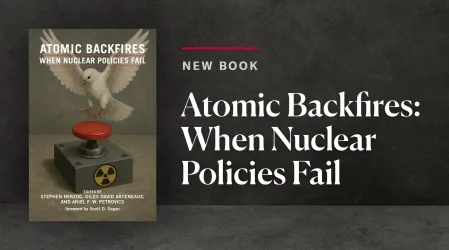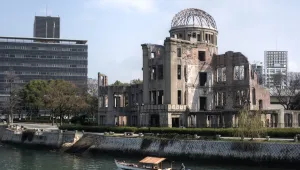With a foreword by Kevin Ryan
The views expressed in this paper are those of the author alone and should not be interpreted as representing the official views of Supreme Headquarters Allied Powers, Europe or the North Atlantic Treaty Organization.
INTRODUCTION: Gorbachev’s and Putin’s Different Strategic Choices to Enhance Global Competiveness
In 1985, a Soviet leader came to power, leading one of the two superpowers in a bi-polar world, commanding a powerful military, and leading a party mandated with changing the world. Mikhail Gorbachev was also equipped with something far more powerful than the weapons in the Soviet arsenal—forecasts of the USSR’s future inability to compete with the United States in economic, technological, and military terms. Gorbachev was convinced that the Soviet war economy and its priorities would constrain and exhaust its national capacity to compete successfully at the end of the 20th century—and that the internal system needed change for the USSR to sustain itself as a competitive, global power.
Gorbachev decisively chose economic reforms and disengagement from strategic confrontation with the West to address Soviet non-competitiveness. Internal political and economic changes to the Soviet system were intended to strengthen the USSR and renew its economic and technological base for sustained global competition in the 21st century. He disengaged the Soviet Union from external strategic confrontation through conventional and nuclear arms reductions, changed Soviet security and defense policies, and reduced arms expenditures. Gorbachev’s choice ended decades of direct military confrontation between the Soviet Union and NATO, and Eastern Europe’s political revolutions ultimately led to the geographic separation of Soviet and NATO military forces. In 1991, Gorbachev was swept from power by the political and economic forces unleashed by his attempted internal reform of the USSR.
30 years later, another Russian leader driven by similar concerns about future strategic non-competitiveness has set this country on a path to address and reverse its non-competitive position in the world. Vladimir Putin’s Russia today, however, is on a very different course from Gorbachev. After implementing liberal economic reforms aimed at strengthening Russia’s sovereignty in the early years of his rule, Putin has rejected structural, internal economic and political reforms, fearing that like Gorbachev he too could be swept from power. Putin’s choice reflects a view that Russia can only address its non-competitiveness by changing the world around Russia, and most critically, by changing the European security system. In Putin’s view, any solution short of changing the European security system—including full integration, separation by erecting new walls, freezing the status quo around Russia, or partnering with other countries to counter-balance the powers in the European system—only means Russia’s inevitable loss of great power status and the loss of his personal power at home.
Consequently, Putin is rearming Russia, remilitarizing Russia’s overall approach to security, changing Russia’s defense concepts, adopting continuous destabilization strategies against neighboring states, and returning to old policy formulas for internal and external security—all justified and rationalized by the perceived threat posed by the U.S./European security system around Russia. His policy requires a changed Europe to enhance Russian strategic competitiveness and requires a changed Europe to avoid political change inside Russia. These two Russian campaigns—one external and one internal—are interfused. Success in one campaign is dependent on success in the other. More importantly, failure in one campaign is perceived as prompting failure in the other.
President Putin’s decision is influenced by Russia’s experiences since the end of the Cold War—internal coup attempts, terrorist attacks, ‘colored revolutions’ around Russia, wars inside and outside of Russia, unfinished reforms, and perceptions of Russia’s natural vulnerability to a fate similar to that of the USSR given its one-dimensional economic base and political superstructure. However, Putin’s policy is driven mostly by concerns about Russia’s inability to compete on almost any level and in almost any sphere with the world’s greatest powers absent fundamental changes to the security, energy, economic, and financial systems around Russia.
Russia does have long-standing critical views of the European security architecture. U.S. and NATO Ballistic Missile Defense programs, a variety of NATO and EU policies and actions, and US security and defense integration on the continent have been a few of the many points of criticism from Moscow over the years. Dimitri Medvedev, then the President of Russia, proposed a new European security architecture shortly after the Russian conflict with Georgia in 2008 to change the European security system. While Putin’s policy is consistent with well-documented Russian criticisms of Europe’s security architecture, his actions differ substantially from previous Russian approaches. Previous Russian approaches could be characterized as attempting to ‘break into” the European security system to politically divide and overrule. In contrast, Putin’s current approach attempts to ‘breakout’ of the European security system, divide Europe, and establish new rules. This is a fundamental change of approach that reflects a fundamental change of policy.
Russian political and military experts also have long envied the Chinese security model. In many ways, Putin’s Russia seeks a security system in Europe that resembles the security environment China has in the Pacific. For the Chinese, there is no real Asian-wide architecture of transpacific security akin to Europe’s transatlantic security that collectively counter-balances national power. China is able to use its economic and military strengths with a wider range of freedom, acting opportunistically, wielding its power to divide and overrule, protect territories and interests, and navigate its strengths in a security environment with strategic, but isolated pockets of US-Pacific defense integration. Simultaneously China has integrated economically, gained access to technology, modernized its economic system, and maintained continuity in political control over the internal system. Russian security experts also have admired the fact that China has evolved and grown into a great economic power without the political and economic turmoil Russia suffered in the 1990s—turmoil that has cost Russia time, money, energy, and opportunity.
Russia’s leadership wants a Europe without strategic Alliances, without multi-national organizations, and without a U.S.-Europe Transatlantic link that can through collective policies and action offset the national strengths Russia would hold over any one European nation. It would be a European security environment that would allow the Russia to apply its national strengths to great effect without challenge and competition - enhancing its power abroad and at home. This is the end-state of Putin’s strategy, and it requires changing the European security system—the rules of the game—to sustain Russia’s capability to compete with Europe and other regional powers poles outside Europe. Conversely, the policy strictly seeks to freeze the political rules of the game inside Russia, and end meaningful political competition at home.
Russia’s leaders have concluded that the European system is both vulnerable and unjust.1 In the Russian view, the European security system is vulnerable because it is weakened by a diffusion of global power, political devolution, sapped of economic wealth, and attacked by forces of disorder in other parts of the world. Putin also has concluded that the current European security system is unjust because it confines and restricts Russia’s ability to exercise her inherent national strengths, inflicting a modern form of multi-dimensional, multi-level strategic encirclement of Russia. Russia’s leaders claim the European security system is part of a global system whose purpose is to advance a unipolar, US-dominated global order.2 Moreover, Russia’s leaders assert that preventing Russia from attaining its proper place in a just global order is a prerequisite to sustain the current unjust global order. Russia’s policy seeks to change first the principles and rules upon which Europe and other countries have prospered and grounded their economic and military security, then replace them with new principles and new rules that would enhance the strengths of an unreformed, Putin-led Russia and compensate for its weaknesses.
As Russia’s campaign against Ukraine has demonstrated, this is a ‘rule breaker to be rule maker’ strategy, and the strategy relies on a variety of internal and external means to achieve its ends. Internally, the strategy feeds nationalism, familiarity, and orientation to the disempowered Russian people, offers the prospect for greater profit to the powerful rich, and promises purpose, identity, and resources to the power ministries (e.g., Ministry of Defense, Ministry of Interior.). Externally, the strategy relies on the use of all elements of power—including military—to discredit, devalue, and delegitimize the current European security system.
The roots of this strategy have many antecedents in Soviet policy, yet his policy is not that of the Soviet Union. Nor is it a policy that strictly and narrowly follows nationalist aims for redrawing borders to revive a Novorossiya or rebuild the Soviet empire. His policy is a mixture of the very old, old, and new in a completely different global strategic context. Putin needs the Russian people, the country’s powerful rich, and the power ministries to support his policy. The Soviet-inspired symbols, messaging, and parades, the nationalism associated with a Great Russia, the rearmament, increased defense budgets, the declarations of an unjust peace at the end of the Cold War, and the accommodation of the narrow financial interests through new energy contracts with China and others are used to fuel support for his policy at home and attempt to legitimize it abroad.
President Putin has merged these three lines of ideas, ideals, and vision for Russia into a single system of thought, policy, and action to drive his strategy and build support internally for his agenda. Righting the perceived wrongs inflicted on Russia and rebuilding Russia’s power, prestige, and place in the former Soviet space after its perceived humiliation at the end of the Cold War are the public lines of Russian policy. Away from public view, Putin constructs unchallengeable political control over Russia that is built on the narrow aims of a Kremlin leadership interested in obtaining more wealth and more power. Individually, these public and non-public lines of effort are single elements of Putin’s policy, each with their own appeal to their targeted audience. However, these three lines of Putin’s policy are mixed together into a single political and strategic military logic for breaking out of the perceived strategic encirclement of the European security system around Russia to establish a stronger, more globally competitive Russia.
To read the full report, please see the PDF below:
Covington, Stephen R.. “Putin's Choice for Russia.” Belfer Center for Science and International Affairs, Harvard Kennedy School, August 2015



